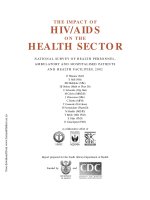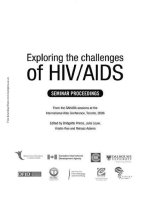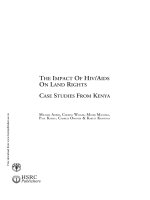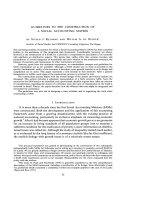AVAHAN– THE INDIA AIDS INITIATIVE: The Business of HIV Prevention at Scale ppt
Bạn đang xem bản rút gọn của tài liệu. Xem và tải ngay bản đầy đủ của tài liệu tại đây (1.29 MB, 40 trang )
Publications from Avahan in this series
Avahan – The India AIDS Initiative: The Business of HIV Prevention at Scale
Off the Beaten Track: Avahan’s Experience in the Business of HIV Prevention among India’s Long-Distance Truckers
Use It or Lose It: How Avahan Used Data to Shape Its HIV Prevention Efforts in India
Managing HIV Prevention from the Ground Up: Avahan’s Experience in Peer Led Outreach at Scale in India
The Power to Tackle Violence: Avahan’s Experience with Community Led Crisis Response in India
Managing HIV Prevention from the Ground Up:
Avahan’s Experience in Peer Led Outreach at Scale with Injecting Drug Users in India
Also available at: www.gatesfoundation.org/avahan
AVAHAN–
THE INDIA AIDS INITIATIVE:
The Business of HIV Prevention at Scale
BILL & MELINDA GATES FOUNDATION
4
•
Avahan—The India AIDS Initiative: The Business of HIV Prevention at Scale. 2008
This publication was commissioned by the Bill & Melinda Gates Foundation in India. We
thank all who have worked tirelessly in the design and implementation of Avahan. We also
thank Chris Parker who assisted in the writing and production.
Citation: Avahan—The India AIDS Initiative: The business of HIV prevention at scale.
Bill & Melinda Gates Foundation. New Delhi, India. 2008.
AVAHAN—THE INDIA AIDS INITIATIVE
Avahan—The India AIDS Initiative: The Business of HIV Prevention at Scale. 2008
•
5
CONTENTS
Avahan—The India AIDS Initiative 7
The Foundation's Considerations and Response 8
Avahan Program Design 10
Targeting high-risk populations 10
Intervention geographies 10
The prevention package for high-risk groups 11
The prevention package for men at risk 15
Advocacy to support implementation 16
The Avahan Implementation Approach 17
Designing for scale 18
Organizing for scale 19
Executing and managing for scale 21
Measuring Impact and Monitoring Progress 25
Measuring impact 25
Monitoring progress 26
Preliminary results 28
Learnings 30
The Future 32
Appendix 33
References 35
Glossary 37
x
AVAHAN—THE INDIA AIDS INITIATIVE
Avahan—The India AIDS Initiative: The Business of HIV Prevention at Scale. 2008
•
7
I
n 2003 the Bill & Melinda Gates Foundation began its large HIV prevention program, the India AIDS Initiative,
later called Avahan, to curtail the spread of HIV in India. At the time, there was an understandable sense of
urgency about the rising prevalence of HIV in the world's second most populous country.
The foundation had three primary goals for this initiative:
1. Build an HIV prevention model at scale in India
2. Catalyze others to take over and replicate the model
3. Foster and disseminate learnings within India and worldwide
Avahan has successfully built a large-scale HIV intervention program in its first five years. It operates in six states
in India, which have a combined population of 300 million people. Within these states, it provides prevention
services to nearly 200,000 female sex workers, 60,000 high-risk men who have sex with men,
* and 20,000
injecting drug users, together with 5 million men at risk.
Avahan is now, in keeping with its second goal, beginning to hand over the program to "natural owners," like the
Government of India and communities it has served since the beginning.The program has also begun work on the
third goal of disseminating learnings from this initiative, and this document is a part of that effort.Throughout this
document, "Avahan" refers to the effort of the partner organizations, hundreds of grassroots NGOs, thousands of
peer educators, and others working on this initiative.
This publication describes the Avahan initiative and provides an overview of the evolution of the Avahan strategy
and its implementation; a description of the key elements of the program and how Avahan achieved its first goal
of rapidly rolling out services to a large and hard-to-reach population across a large geographic area; how Avahan
monitors and evaluates the initiative; the preliminary results and learnings; and its plans for the future.
AVAHAN—THE INDIA AIDS INITIATIVE
* Definitions of terms used in the publication can be found in the Glossary at the end of this document.
Avahan addresses
nearly 280,000
individuals from
populations most at
risk and
approximately 5
million men at risk
BILL & MELINDA GATES FOUNDATION
8
•
Avahan—The India AIDS Initiative: The Business of HIV Prevention at Scale. 2008
THE FOUNDATION'S
CONSIDERATIONS AND RESPONSE
B
y 2003, increased funding and advocacy for care and treatment had led to HIV prevention losing emphasis
among HIV practitioners. Globally there was evidence that working with populations at greatest risk
(high-risk groups) and bridge populations in early and concentrated epidemics translated into HIV
reduction among general populations.
1
However, there were few examples of HIV prevention interventions that
provided services for a large portion of high-risk individuals at a country or regional level. This resulted in
prevention practitioners calling for a "bridging of the prevention gap" by increasing access of high-risk groups to
a combination of proven interventions.
2
In 2003, UNAIDS studies reported that Asia presented the greatest risk of expansion of the global epidemic.
3
Experts believed that the region accounted for 20 percent of infections at the time and projected that in the
absence of a vigorous prevention response, Asia could contribute up to 40 percent of all new infections globally
by 2010.
4
Estimates by the Indian government placed the number of HIV-infected people at 5.1 million. By 2002,
government surveillance data gathered from attendees at government-run antenatal clinics (ANC) showed that
HIV prevalence was over one percent in 51 districts across India (1-4 million people per district).
5
Of these, 39
districts were located in four southern and two north-eastern states of India.
In India, and in most of the rest of Asia, two major factors contribute to the growth and the ultimate size of the
HIV epidemic.These are the population of sex workers and their clients, and then the frequency of unprotected sex
Figure 1: Asian HIV Transmission Dynamics
AVAHAN—THE INDIA AIDS INITIATIVE
Avahan—The India AIDS Initiative: The Business of HIV Prevention at Scale. 2008
•
9
Avahan's Strategic Choices
The following are key strategic choices made in the initial design and subsequent evolution of Avahan:
1. Focusing prevention efforts on high-risk groups
2. Concentrating efforts on the six states with the majority of HIV cases at the time
3. Basing the initiative on global best practices in HIV prevention
4. Scaling services across intervention geographies rapidly to contain the spread of the epidemic
5. Creating the foundation's first in-country office to facilitate rapid scale-up
6. Investing in knowledge-building, evaluation, and dissemination
7. Articulating an explicit goal to transfer the funding and management of the program to natural owners
including government and communities
between them.
6
Injecting drug users and men who have sex with men are also at risk and contribute to the overall
epidemic. Limited data from published studies and sentinel surveillance of high-risk groups in India at the time
indicated that HIV transmission in south India was primarily sexual, and in the north-east mainly related to
injecting drug use.
7
The Indian national response had a sound strategy addressing high-risk groups. However, coverage of these groups
was variable, and in general low.
8,9
The foundation initiated a design process with a team of technical experts.They
conducted a careful review of data on the epidemic and looked at the prevention program coverage by existing
Government of India and other donor-supported programs. After consultation with the Government of India, the
foundation began Avahan in mid-2003. The initial funding commitment for the India AIDS Initiative was US $200
million for five years, with an additional US $58 million committed in 2006.
Avahan's aim was to help slow the transmission of HIV to the general population by raising prevention coverage
of high-risk and bridge groups to scale by achieving saturation levels (over 80 percent) across large geographic
areas.
10
Experts thought such an approach would be difficult to accomplish in India, due to the scale and diversity
of the country and the risk of further stigmatizing these groups.
Given the charter,size, and anticipated complexity of the initiative, the foundation opened an India office with local
staff to manage the initiative. Staff with a mix of for-profit and public health backgrounds were recruited with the
intent of marrying the private sector management and public health skills necessary for quickly rolling out such a
large-scale program.
BILL & MELINDA GATES FOUNDATION
10
•
Avahan—The India AIDS Initiative: The Business of HIV Prevention at Scale. 2008
* All program statistics are as of December 2007, unless otherwise specified. The roll-out of the third phase of the National AIDS Control Program resulted in
some changes in Avahan geographies.
AVAHAN PROGRAM DESIGN
A
vahan was conceived as a focused prevention program—reaching high-risk groups and bridge
populations, in geographies most affected, with a known package of prevention interventions. The
following sections describe the program design.
Targeting high-risk populations
The program focuses on providing coverage to high-risk groups: female sex workers, high-risk men who have sex
with men, transgenders known as
hijra
, injecting drug users, and clients of sex workers, who are covered under
men at risk interventions. While this focus on high-risk and bridge populations addresses the major epidemic
drivers in India, transmission from already infected men to their partners requires additional interventions. The
second National AIDS Control Program (2000 - 2006), through its expansion of HIV testing centers and focus on
preventing HIV transmission in pregnancy, was already addressing this gap. This has since been expanded in the
third phase of the National AIDS Control Program.
Intervention geographies
The six states that Avahan decided to work in accounted for 83
percent of the HIV infections in India in 2002.
11
These states—
Tamil Nadu, Karnataka, Andhra Pradesh, Maharashtra,
Nagaland, and Manipur—together comprise a large area, with
a combined population of 300 million, approximately the size of
the population of the United States. They vary greatly in terms
of language and culture, and also in the stage and drivers of the
HIV epidemic, and length and extent of prior HIV prevention
interventions. The foundation staff worked closely with
national- and state-level AIDS control authorities to identify
districts in which Avahan would operate interventions. The intent was to avoid duplication
and to ensure complementary coverage programming within the high-risk groups and bridge
populations.
As of December 2007,* Avahan supports prevention programs for approximately 279,000 high-
risk individuals in 605 towns, in 83 out of 130 districts in these six states. Avahan works either
alongside government- or donor-supported NGOs, or as the sole HIV prevention service provider
for these groups in a district. In two of the southern states Avahan provides sexually transmitted
infection (STI) clinical services for sex workers who receive other prevention services from the
government or other donors' programs.
In the four southern states, Andhra Pradesh, Tamil Nadu, Karnataka, and Maharashtra, Avahan also provides
prevention services to approximately five million men at risk, including men congregating at sex solicitation venues
("hotspots") and long-distance truckers. These services are concentrated in the main 100 towns in the districts
Avahan decided to
work across six
states in India that
accounted for 83%
of the country's
HIV infections
AVAHAN—THE INDIA AIDS INITIATIVE
Avahan—The India AIDS Initiative: The Business of HIV Prevention at Scale. 2008
•
11
where Avahan has operations. Avahan also works along 8,000 km of primary trucking routes
along national highways to reach a mobile population of two million long-distance truckers.
Long-distance truckers are essential to the strategy. They are an identifiable and
programmatically addressable segment of men at risk, accounting for approximately 10-12
percent of the clients of female sex workers.
The prevention package for high-risk groups
The Avahan package of prevention interventions is designed to address both proximate and distal determinants of
HIV risk.
12
Proximate determinants of risk include factors such as presence of STIs, condom use, type and frequency
of sexual activity, and type of partner. Prevention services such as outreach, behavior change messaging on safe
sex, free or socially marketed condom distribution, needle and syringe exchange (for injecting drug use), and
treatment of STIs address proximate determinants of risk. Distal determinants include stigma, violence, legal
environment, medical infrastructure, mobility and migration, and gender roles. They are addressed through
structural interventions and community mobilization aimed at reducing stigma, violence, and barriers to accessing
entitlements.
13
Avahan's package of prevention services has proven effective elsewhere in decreasing STI and HIV rates among
high-risk groups
14,15
and is consistent with the overall strategy of the National AIDS Control Organization in India.
Avahan has operations
in 605 towns across
six states
Figure 2: Saturating Coverage through Complementary Programming
BILL & MELINDA GATES FOUNDATION
12
•
Avahan—The India AIDS Initiative: The Business of HIV Prevention at Scale. 2008
Figure 3: Avahan Intervention Sites for Men at Risk -
Hotspots and Truck Stops
Figure 4: Avahan Intervention Sites for High-Risk Groups in Six States
National Highway
Trucker intervention locations (17)
Male client program states (4)
Male “hotspot” intervention site (100)
Avahan districts (83)
Nagaland
Manipur
Andhra Pradesh
Tamil Nadu
Karnataka
Maharashtra
Salem
Dharmapuri
Guntur
East Godavari
Khammam
AVAHAN—THE INDIA AIDS INITIATIVE
Avahan—The India AIDS Initiative: The Business of HIV Prevention at Scale. 2008
•
13
The Avahan program elements for high-risk groups include:
1. Peer led outreach education
2. Program supported clinical services to treat STIs other than HIV
3. Commodity distribution—promoting and distributing free condoms for sex workers and needle and syringe
exchange for injecting drug users
4. Facilitating community mobilization and capacity for community ownership of the program
Peer led outreach and education
Outreach to high-risk individuals by peer educators drawn from the same community is a vital part of Avahan's
HIV prevention efforts with female sex workers, high-risk men who have sex with men, injecting drug users, and
truckers. Peer educators identify those among their social network who are at greatest risk and provide support
and information that help improve their ability to negotiate condom use and their attendance at STI clinics and
self-help programs. For more information, see the Avahan publication on peer led outreach.
16
Management of STIs
Avahan has established 412 program-funded clinics that have provided free STI diagnosis and
treatment services at least once for an estimated 340,000 individuals.* All Avahan partners and
the grassroots NGOs follow uniform protocols for STI management, which are locally adapted
from the
Clinic Operational Guidelines and Standards
for STI management developed by Avahan.
17
At all service sites, STIs are addressed through a combination of presumptive treatment,
syndromic management, and regular screening. Avahan's peer educators help drive attendance
at the clinics, encourage sex workers and others to promote utilization, reinforce condom use, and
facilitate follow-up and partner treatment. These clinics are also linked to other clinical services including HIV
testing centers, tuberculosis testing and treatment centers, and HIV care including antiretroviral treatment.
Using Peer Outreach and Micro-planning to Improve Avahan's Reach
As part of continuous program improvement,Avahan partners use "micro-planning" as an approach to fine-tune
implementation at the grassroots level. Micro-planning involves peer educators gathering detailed, multi-faceted
information from "hotspots" (high-risk venues where commercial sex is solicited) to understand the nature of
intervention needed.This is followed by systematic, ongoing outreach to the high-risk groups in these venues. Peer
educators manage and monitor 25-50 peer members in their assigned group and work about four hours per day.
Their activities include sharing prevention information with their colleagues, distributing condoms (and as
appropriate needles and syringes), making referrals to clinics and other services, and gathering information on
each individual's risk profile, including their vulnerability to violence and their ability to access services. Data are
recorded with low-literacy tools. Their micro-planning records are discussed during weekly meetings with peer
supervisors or field officers who monitor performance, provide additional training, and help the peer educators
prioritize her/his workload. The process of peer training, supervision, and problem-solving empowers members of
the communities and prepares the ground for the community to eventually take over management of components
of the program itself. It also fosters leadership among individuals who can go on to advocate for the wider rights
of these groups.
Avahan distributes
about 10 million
free condoms each
month
* Due to high mobility and turnover in the high-risk groups, the number of individuals accessing clinical services at least once is larger than the estimated
denominator in Avahan intervention areas.
BILL & MELINDA GATES FOUNDATION
14
•
Avahan—The India AIDS Initiative: The Business of HIV Prevention at Scale. 2008
However, Avahan partners in the states and grassroots NGOs adapt service delivery approaches to meet the needs
of the high-risk communities in their areas. This might entail establishing fixed clinics close to hotspots, or mobile
clinics in vans or tents. These are supplemented by satellite clinics or pre-scheduled clinic days within brothels. In
areas with low numbers of high-risk group members, private providers are trained and contracted to provide
clinical services.
Free prevention commodities distribution
As of the end of 2007, Avahan partners distribute approximately 10 million free condoms monthly to sex workers,
high-risk men who have sex with men, and injecting drug users. NGOs and their peer educators estimate the
number of condoms needed by high-risk groups based on the number of commercial partners. These condoms are
in turn distributed by peer educators within their network. The need for lubrication with condoms has been
addressed in some areas by working with condom manufacturers to increase the lubrication in packaged condoms,
and by the distribution and social marketing of lubricant. In two north-eastern states, Avahan also supports a free
needle and syringe exchange program for injecting drug users.
Community mobilization
Community participation is critical to the success of any
development initiative,
18
and globally, community mobilization
is considered essential to HIV/AIDS programming. In addition to
risk-reduction services, Avahan provides interventions to
address factors contributing to the vulnerability of high-risk
groups.Avahan works with high-risk communities to strengthen
their individual and collective agency so that they can adopt
and sustain the practice of safer behavior.
19
The process of community mobilization began with the
recruitment of community guides to map the high-risk
populations in each of the Avahan districts. As services became
established, interested and skilled community members were
engaged as peer educators. They undertook systematic efforts to determine the needs of individuals through social
network mapping and micro-planning. Additionally, they began advising the program on key issues such as the
location of clinics and drop-in centers, and hiring of doctors or contracting of private providers. The program made a
concerted effort to recruit community members to work in clinics, run drop-in centers, and oversee outreach. One
natural consequence of this deliberate and formal engagement with high-risk communities was the strengthening of
skills and confidence among a large base of individuals.
As the program expanded, it created a platform for increasing numbers of community members to interact with
each other. They started coalescing and expressing greater interest in directly engaging with issues of major
importance to them. These included stigma (of HIV and of belonging to marginalized groups), violence inflicted by
authority figures such as police or clients, and denial or non-availability of essential entitlements such as ration
cards. In many parts of the program, community members began forming self-help groups. The program instituted
formal skills training for community members in areas such as media handling, advocacy, and legal literacy. With
the support of the program, community members increasingly started shaping the local advocacy activities and
leading activities such as the violence response systems and negotiations with local power structures.
Today community groups, some with legal registration and annual membership fees, exist in more than half of
Avahan's 83 districts. Their participation and leadership continue to evolve as they lead activities in 650 drop-in
AVAHAN—THE INDIA AIDS INITIATIVE
Avahan—The India AIDS Initiative: The Business of HIV Prevention at Scale. 2008
•
15
centers across the program and begin to mobilize with a collective voice to oversee programs and
advocacy with the government.
The prevention package for men at risk
The program elements for men at risk differ from those for high-risk groups in scope and intensity
and include:
1. Enhanced distribution and social marketing of condoms. This is complemented by a condom
normalization effort that uses mass media to promote the use of condoms.
2. Behavior change communication activities using interpersonal, mid-, and mass media.
3. STI treatment either through clinical services provided in truck stops or through a franchised
network of private STI providers.
Condom social marketing and normalization
The lack of widely available condom stocking retail outlets outside conventional family planning services supported
by the government or traditional outlets like chemist shops was identified as a major structural barrier to safe sex
between male clients and female sex workers.This was especially so in the states of Karnataka and large tracts of
interior Andhra Pradesh. Avahan's social condom marketing efforts aim to address this particularly through the
creation of non-traditional outlets in all the southern districts in which Avahan works. Examples of non-traditional
outlets include tea and
pan
shops (tobacco and cigarette shops), roadside restaurants, local all-purpose grocery
stores, vending machines at truck stops, and health clinics. This effort is supported by promoting condom
normalization through a combination of active mid-media efforts (street theatre, retailer promotions) and mass
media campaigns (television, radio, movies, billboards). Over 147,000 outlets stocking condoms have been opened
by Avahan in high-risk venues in the four southern states and across the national highways. By the end of 2007
these outlets were selling about 5 million socially marketed condoms per month to men at risk.
Behavior change communications with men at risk
Men at risk are reached with behavior change communication efforts in places where they are found in high
numbers such as hotspots or in transshipment locations along the national highways. Both one-on-one and one-
to-group interpersonal communication sessions are held.A variety of different mid-media activities such as drama,
street theatre, entertainment shows, and competitions are also used to provide education on HIV, STI symptoms
and treatment, safe sex, and condoms. In December 2007 alone about 650,000 men in hotspots and
transshipment locations participated in an interpersonal or mid-media event.
STI clinical services for men at risk
STI services for men at risk are delivered differently to men at risk at hotspots or to truckers at transshipment
locations. In the 100 focus towns, a franchise of privately owned clinics (branded as "Key Clinics") was built around
major hotspots. This network of 736 clinics provides fee-paid STI consultations and treatment. The clinics were
established by identifying physicians who were already seeing a high volume of STI cases and enrolling them into
the franchise. Franchise participants were given training on STI management, and the clinics were branded
uniformly. They were also promoted through mass media and local promotions at the hotspots. Pre-packaged STI
syndromic treatment kits containing antibiotics, condoms, instructions, and partner referral cards were developed
to improve provider prescribing and patient adherence. These pre-packaged kits are sold through the clinics and
through chemist' shops in the vicinity.
Avahan reaches up
to 650,000 men at
risk through
interpersonal or
mid-media events
each month
BILL & MELINDA GATES FOUNDATION
16
•
Avahan—The India AIDS Initiative: The Business of HIV Prevention at Scale. 2008
STI management needs for truckers at truck stops are addressed through program-funded clinics located at major
transshipment locations along the national highways. These clinics are branded, provide free consultation services,
and either sell pre-packaged prescription kits or write prescriptions.
Over 5,500 men per month seek care for an STI in one of these service site mechanisms—the transshipment clinics
and the Key Clinics. For more information on Avahan's work providing STI clinical services for truckers, see
Avahan's publication on trucker programming.
20
Advocacy to support implementation
The foundation has invested in a set of advocacy initiatives to
support the core implementation program.The three main focus
areas of Avahan's advocacy efforts have been:
1. Increasing the commitment to, and resources for, HIV
programming in India
2. Reducing stigma—both around HIV as well as around
marginalized groups (e.g., female sex workers, men who
have sex with men, and injecting drug users)
3. Addressing issues in the local environment that prevent
adoption of safe sex practices and access to entitlements
(e.g., violence, police harassment)
The long-term prevention of HIV requires the sustained efforts
of government and civil society. Since the beginning of the
Avahan initiative, there has been much advocacy to increase
funding and political support for HIV prevention, and to
encourage greater dialogue around the issues of HIV and AIDS.
Other advocacy endeavors include efforts to alter police
practices that harm HIV prevention programming (e.g., the
arrest of sex workers for carrying condoms). High-risk groups
are also educated about their legal rights, to prevent such
abuses of power against them. A major effort has also been
underway to improve the quality and quantity of HIV media
coverage in vernacular papers across the six Avahan focus
states. Avahan partners conduct wider public education and mass media outreach addressing the stigma faced by
people infected with HIV. Avahan collaborates with national film celebrities, sports stars, and business leaders to
reach millions of people through public service announcements. These efforts attempt to address societal
perceptions that lead to stigmatization of HIV and high-risk communities.
AVAHAN—THE INDIA AIDS INITIATIVE
Avahan—The India AIDS Initiative: The Business of HIV Prevention at Scale. 2008
•
17
Figure 5: Roll-out of Footprint and Services
THE AVAHAN
IMPLEMENTATION APPROACH
A
vahan's charter of building an HIV prevention model across such a large geography and for such a large
population required an implementation approach—the design, the organization, and the execution—
oriented to that goal. Avahan scaled up infrastructure and services rapidly—at the end of two years of
implementation 83 percent of the enumerated high-risk population had been contacted by a peer outreach worker
at least once.
BILL & MELINDA GATES FOUNDATION
18
•
Avahan—The India AIDS Initiative: The Business of HIV Prevention at Scale. 2008
Avahan's approach to scaling up across intervention geographies was based on the principles of:
• Designing for scale
• Organizing for scale
• Executing and managing for scale
Designing for scale
Prior to intervention start, Avahan partners conducted detailed size estimations of high-risk groups across the
districts they were to cover. These exercises helped establish an initial denominator against which Avahan planned
scale-up of services. These initial estimates have since been refined by Avahan partners every 18–24 months for
two reasons. First, as the program expanded and established trust with the communities, the estimates were
validated through ongoing services. Second, some adjustments were required periodically due to mobility and
turnover among these groups.
Based on this mapping and size estimation exercise, key locations that contained large concentrations of high-risk
populations were identified as priority areas. This was done without compromising the need for simultaneous
scale-up for different populations across different districts. For example,Avahan saturated coverage of sex workers
in major urban areas with the highest populations before expanding sex worker coverage to less dense, peri-urban
areas. The two male client programs focused on intervention locations with the highest concentrations of men
at risk.
To support the roll-out of services, Avahan created a set of standardized basic program elements to guide
implementation and monitor quality of the interventions. Using input solicited from the extended Avahan
organization, Avahan created a "Common Minimum Program"—a set of basic implementation standards for
technical and managerial areas to guide programs, while giving them the flexibility to customize implementation
based on local needs. This was complemented by the
Clinic Operational Guidelines and Standards
for STI
management, which provided a minimum set of standards for STI treatment services. The Common Minimum
Program is a living document which has already undergone three revisions over five years, allowing for innovations
at the local level to be channeled back to the Avahan program level.
AVAHAN—THE INDIA AIDS INITIATIVE
Avahan—The India AIDS Initiative: The Business of HIV Prevention at Scale. 2008
•
19
Avahan's Common Minimum Program
The Common Minimum Program (CMP) aims to build a common vision and define a set of operating standards
for the Avahan virtual organization (see below). In its larger sense, the CMP includes well-documented guidelines
for programmatic and technical approaches, key project milestones, a common management framework, and a
common set of indicators against which the program could be monitored.
Programmatic and technical standards aim to facilitate a program-wide common minimum approach to
launching and running interventions on the ground,
supported by guidelines and, where appropriate, tools. The
guidelines cover the following areas:
• Community participation
• Clinical services for prevention
• Outreach and behavior change communication
Key project milestones aim to provide time-bound measurable targets for the program to guide intervention.
T
hese quantitative milestones cover pace of infrastructure and service roll-out as well as specified desired service
utilization levels. These targets form the basis of regular reviews and discussions across partners. The milestones
in the CMP have evolved with the program life-cycle from start-up to mature phase and at each stage have helped
set direction and clarify priorities across the Avahan organization, thereby phasing the program.
Common program management framework articulates the management process for execution. These include:
•
Defined relationships across the virtual organization and clarified ownership of specific areas for lead
implementing partners (see following page), capacity building and other partners, NGOs, and peers
• Management support guidelines for such areas as intensity of field engagement and relationship with local
stakeholders
• Formal review process guidelines
Data collection for decision-making includes tools and processes for data collection and analysis to inform
decision-making at all levels
. This includes metrics for program-wide analysis of Avahan, predictive and warning
capabilities for a district, the ability to look at individual NGO level data, and individual risk assessment and
planning by peers. These include:
• Grassroots up to program-wide routine monitoring metrics and indicators
• Qualitative assessments
• Quantitative assessments (surveys)
• Repeat mapping and size estimation exercises
• Estimated condom (or needle/syringe) needs of target community
Organizing for scale
Avahan may be viewed as a virtual organization composed of several different entities including local and
international NGOs, universities, and research organizations.This virtual organization structure was designed with
the explicit intent of enabling rapid and simultaneous scale-up across geographies, facilitating standardization of
key elements, and sharing of best practices across all implementation programs. Avahan partners include:
1. Lead implementing partners, who grant to and support grassroots NGOs
2. Capacity building partners
3. Other supporting partners
4. Monitoring and evaluation partners
5. Knowledge building partners
BILL & MELINDA GATES FOUNDATION
20
•
Avahan—The India AIDS Initiative: The Business of HIV Prevention at Scale. 2008
Lead implementing partners
Between December 2003 and March 2004, Avahan made its major implementing grants. Seven of the nine lead
implementing partners work at the state level on prevention programming for high-risk groups.The remaining two
grants support programs for men at risk. These large national or international NGOs sub-grant to, manage, and
support 134 grassroots NGOs.
Capacity building partners
Capacity building partners have worked with lead implementing partners to set Avahan-wide standards and raise
capacity levels in key technical areas (STI management, interpersonal communication, community mobilization,
and advocacy) to facilitate rapid, quality program scale-up and improvement. As program improvements in these
key technical areas have been secured, many of these capacity building partners have been phased out.
Other supporting partners
A number of other partners address advocacy and communications. These partners work on a wide range of
activities including development of mass media campaigns to address issues such as stigma and discrimination
against HIV and promoting condom use. Others work to improve the quantity and quality of reporting on HIV in
the English language and vernacular press at the state level, and assist in national-, state-, and local-level
advocacy strategy development.
Evaluation partners
Evaluation partners are responsible for implementing Avahan's monitoring and evaluation framework.
Knowledge building partners
Knowledge building partners are responsible for generating learnings around issues that can inform HIV
prevention programming. These include the role of mobility and migration in the HIV epidemic; structural
interventions and their impact on risk behaviors and vulnerability; and the management of STIs.
Figure 6: The Avahan Organization
AVAHAN—THE INDIA AIDS INITIATIVE
Avahan—The India AIDS Initiative: The Business of HIV Prevention at Scale. 2008
•
21
For more information on each of these partners and their specific roles, please refer to the Appendix.
Executing and managing for scale
The implementation of the program entailed establishing high-quality and accessible services (the supply side) and
addressing barriers to service uptake and increasing interest in the services (the demand side). The virtual
organization described above implemented the program elements across the designated Avahan geographies.
Avahan Governance Structure
Central level:
Gates Foundation office in New Delhi: Thirteen program officers manage the grants, provide technical
input, and manage the day-to-day operations of the overall Avahan initiative.
Technical panels:A technical panel consisting of 17 national and international experts in HIV programming
provides technical counsel for progr
am design, reviews grant proposals, and provides ongoing input and
advice as the program is implemented.
Board of directors: A board of 23 members provides high-profile advocacy and oversight of the initiative.
WHO evaluation advisory group: A World Health Organization-convened team provided technical input
for the ev
aluation design and continues to provide ongoing advice on evaluation issues and analysis as data
become available.
State level:
State advisory committee: Foundation staff, State AIDS Control Societies, program directors of lead
implementing partners in the state, and major state-level HIV stakeholders meet regularly to exchange ideas
and experiences and coordinate activities.
Partner/NGO level:
Community advisory committees: Partners have created fora for community members to provide input
into the project activities in their respective communities, both at start-up and during the life of the project.
BILL & MELINDA GATES FOUNDATION
22
•
Avahan—The India AIDS Initiative: The Business of HIV Prevention at Scale. 2008
Simultaneous creation of delivery footprint
The delivery footprint, Avahan's service infrastructure, was created simultaneously across the entire intervention
geography.This was achieved by ensuring that all the nine service delivery grants were made nearly concurrently and
were coupled with aggressive milestones for the first year. These milestones focused both on soft infrastructure (e.g.,
sub-granting to organizations, hiring human resources including peers, and skills training) and hard infrastructure
(e.g., clinics and drop-in centers, commodity procurement systems) all informed by mapping and size estimation data.
These partners quickly sub-granted to local NGOs, who inherited the overall milestones for their intervention areas.
Avahan's site-level roll-out of prevention interventions was conceived in three distinct but overlapping phases:
1) establishing the prevention infrastructure at each location across intervention geographies; 2) increasing quality and
intensity of coverage of the local community; and 3) expanding the scope of services by layering on select additional
activities (referral linkages with health services and strengthening community participation and leadership) as core
interventions matured. The typical roll-out of prevention interventions at an Avahan site is described in Figure 7.
Figure 7: Phases of Avahan's Roll-out of Services
Start-up
Deciding where and what
• Mapping and size estimation
• Needs assessment
Establishing hard and soft infrastructure
• Staff and peer recruitment and training
• Clinic and drop-in centers
• Commodity and monitoring system developed
Create the physical and virtual
footprint
• Informs prioritization of locations and budget
decisions
• Involves high-risk group community members in
assessment and location choice
• Begins introduction of NGO and services to
community
Roll-out basic services
Matching individuals with services
• Street maps, social network maps
• Typology and degree of risk assessed
• Micro-planning at peer level
Improving service uptake and quality
• Refine monitoring system to focus on quality,
highest risk and least served
• Refine intervention reach through updated mapping
and size estimates
Increase service reach
• Social network and street mapping puts names to
faces
• Micro-planning tailors services to highest risk and
least served and starts building management and
leadership skills in high-risk community
• Quality and monitoring focus ensure sustained
service uptake
Refine scope
Ensuring other health needs are met
• Mapping other services in geography
• Establish linkages
Addressing underlying vulnerabilities
• Violence response
• Local advocacy
Increase community
engagement with program and
HIV prevention
• Addresses barriers to service uptake and generates
demand
• Increases community ownership of services in high-
risk community
AVAHAN—THE INDIA AIDS INITIATIVE
Avahan—The India AIDS Initiative: The Business of HIV Prevention at Scale. 2008
•
23
Customizing services to populations
While the broad technical elements were standardized, the service package and intensity of delivery were
customized by population and location. For example, social marketing is broadly promoted everywhere that Avahan
works with female sex workers and male clients. However, in the 100 towns which have hotspots estimated to
contain 65 percent of female sex workers,Avahan takes a more intensive approach and adds extra mid-media and
interpersonal communication components to reinforce condom use.
For female sex workers, high-risk men who have sex with men, and injecting drug users, program-funded clinics
have been established where Avahan provides clinic space and pays the salaries of the physicians, nurses, and
counselors. In places with fewer numbers of sex workers,Avahan employs a mobile clinic and a physician who visits
on scheduled days, or contracts a private provider to provide services to sex workers at fixed times each day. This
customization of delivery approaches and interventions enables Avahan to maximize reach with available
resources. At the local level, Avahan relies on needs assessments and micro-planning undertaken by peers to
determine the optimal combination and intensity of those services (see "Using Peer Outreach and Micro-planning
to Improve Avahan's Reach," on page 13).
Addressing barriers to service uptake and generating demand
There were two major elements to increasing service uptake in Avahan: reducing barriers and generating demand
for services. Avahan identified major vulnerabilities that inhibited service uptake at a local level such as violence,
stigma, and economic barriers common to marginalized populations (e.g., lack of ration cards and inability to
access social entitlements). These vulnerabilities were addressed through training in legal literacy and local police
advocacy supported by state-level advocacy, and by facilitating linkages to government programs.
Figure 8: Varying Scale and Intensity of Technical Components
BILL & MELINDA GATES FOUNDATION
24
•
Avahan—The India AIDS Initiative: The Business of HIV Prevention at Scale. 2008
Avahan also identified and addressed a few key areas to help generate demand for engagement with the program.
These included, for example, providing primary care services for children in the program-funded clinics, and
earmarking 10 percent of the budget of the NGO to be used for services that are a priority for the local community.
Maintaining execution focus
At every level within Avahan, maintaining a continued execution focus was key to rapid scale-up. The underlying
management process followed at every level included: 1) setting milestones in line with the Common Minimum
Program; 2) frequent and regular field visits by lead partners, capacity building partners, and foundation staff to
attain close knowledge of field realities and customize standards and milestones to local conditions; 3) scrutiny of
routine monitoring data; and 4) regular, frequent, and formal joint progress reviews of the program and the data
to take corrective action as needed. This frequent and close examination of the data resulted in many small course
corrections and a few major shifts in implementation.
One of the central tenets of Avahan implementation, particularly from early 2006, has been the extensive
devolution of data collection and its use for decision-making to the front-line peer educators, allowing them to
tailor service components and coverage intensity to individual community members' needs. The underlying
management process allows for timely refinements, corrective actions, and program shifts. The monitoring and
evaluation system is described in the next section and further details on the use of routine and other data can be
found in the Avahan data use publication.
21
AVAHAN—THE INDIA AIDS INITIATIVE
Avahan—The India AIDS Initiative: The Business of HIV Prevention at Scale. 2008
•
25
Figure 9: Avahan Evaluation Framework
A
vahan has an extensive routine monitoring system, supplemented with large-scale data collection
activities to meet the monitoring and evaluation needs of the program.
Measuring impact
Given Avahan's charter—to build and transfer a scaled program with well-known prevention interventions—it is
essential to document all the processes as a measurement of epidemic impact and program cost-effectiveness.
These measurements include speed, service coverage, quality, and value for money.
Measuring public health impact of a large-scale initiative is complex under any circumstances. Given the diversity
of the epidemic's drivers in India, the initiative's size and complexity, and the multi-player environment that
includes the government and other organizations, measuring Avahan's epidemic impact is even more challenging.
The evaluation framework for the program was conceived in consultation with impact assessment experts from
around the world. This was further refined by the Evaluation Advisory Group (convened by the World Health
MEASURING IMPACT AND
MONITORING PROGRESS









